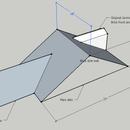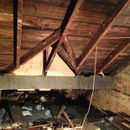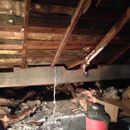Insulating attic with spray / rigid foam
Hello and thank you to everyone who contributes to this site. I’ve enjoyed the articles here and done my best to inform myself. Let me introduce you to my project:
I live in a narrow brick 2-1/2 storey house over 100 years old and I’m preparing to insulate the attic space as a conditioned attic. The climate zone is 5B. The first attachment is a sketch of the basic roof geometry I’m working with.
The larger front portion of the house has parapet walls extending up past the roofline and the attic contained within was finished when I bought the house. It was originally constructed as a walkup attic with a staircase. The dormer in the front is also original as its front and side walls are brick. The rear portion of the house, slightly narrower, has a much shorter roof with ridge perpendicular to the main roof. This part was walled in and unfinished (also uninsulated.) The second and third attachments show the interior main space with the dormer and crawlspace portions just visible, but you can see the angled beams where the rooflines meet. The large crossbeams on either side of the main space prevent the dormer or crawlspace from being fully opened up, but they do seem to do a good job supporting the rafters.
There is ridge venting throughout, however the geometry of the roof leaves only a few rafter bays with clear passage from soffit to ridge. The previous finish dealt with this by hanging drywall below and at an angle to the roofline, leaving a bit of space where the rooflines meet at compound angles for air to get up through to the ridge. There was only a few inches of fiberglass up there and it was pretty gross and compacted when it came out.
I have read much on this site about vented vs. unvented, spray and rigid foam, and insulating above the roof deck. I’m asking in order to help finalize my strategy before I get the materials and start work. The attic is now gutted down to the brick and rafters and I’m getting all the nails and screws out of the roof. I’m hoping to get at least the first layer of insulation in this month. It’s been a cold winter.
Using all spray foam is out of the budget, as is insulating above the roof deck. This is a DIY, retrofit project. However I would like it to be forward compatible with potential future insulation above the roof, whenever the roof needs work. It is presently under 10 years old and in good condition.
My plan is to use a combination of spray foam and rigid foam to achieve R value (I believe I’m shooting for 49) and air sealing. I am leaning towards an unvented approach, applying spray foam directly to the underside of the roof decking, and filling in the rafter bays with 4″ thick pieces of rigid foam, pressing into the spray foam before it cures. The main reason for this strategy is:
a) I have access to rigid closed cell foam, 3′ by 8 to 12′ long, for what works out to be $0.07 / board foot.
b) Venting the roof from soffit to ridge under all that rigid foam will be difficult, due to geometry.
c) I can (barely) afford enough spray foam to do a 1″ thick layer under the main attic roof, or 3/4″ if I do the rear extension as well. This will act as a continuous air barrier.
d) With the space as small as it is, every inch of space counts. The 1-2″ of space for venting channels would come out of the liveable space.
My alternative is to install 1×1 strips alongside each rafter and install the rigid panels to these, leaving a channel underneath. I was trying to figure out a strategy for making this venting continuous, possibly boring holes to provide a passage for air into blocked rafter bays. This just seems hard.
In either case, I plan to insulate all the way to the joists. They were hiding some knob and tube behind the kneewalls that I need time to deal with. The ‘devil’s triangle’ isn’t much of an issue as the kneewalls have been removed and I can get in there to take care of the details.
I plan to address thermal bridging by installing a ceiling supported by new stud walls on either side, also insulated with rigid foam. I may have this ceiling stepped to provide more insulation at the top, where I can afford the space.
My questions are these:
1. Is vented or unvented better in this situation?
2. Is it in any way practical to vent the roof behind rigid insulation, or any insulation for that matter, with this roof geometry?
3. Is there a cheaper alternative to spray foam that I can apply between the rigid foam and the roof deck, that will simply seal it and ensure an air barrier?
I know this is a lower budget project than many discussed here, but I hope that what I lack in dollars I can make up in thoroughness and attention to detail and this will be workable with the materials I can afford. Also, the labour is free here.
Thanks in advance for any input.
Jon
GBA Detail Library
A collection of one thousand construction details organized by climate and house part












Replies
Jon,
Q. "Is vented or unvented better in this situation?"
A. Because the roof geometry does not permit direct soffit-to-ridge venting, an unvented approach makes the most sense.
Q. "Is it in any way practical to vent the roof behind rigid insulation, or any insulation for that matter, with this roof geometry?"
A. No.
Q. "Is there a cheaper alternative to spray foam that I can apply between the rigid foam and the roof deck, that will simply seal it and ensure an air barrier?"
A. No.
For more information on your approach -- the "peanut brittle" variation on cut-and-cobble -- see Cut-and-Cobble Insulation.